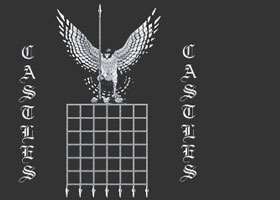Romanesque Architecture - Design
The design of Romanesque Architecture had to be a combination of practical use and the aesthetic design! Romanesque Architecture had to take the following into consideration: - The castle design and Romanesque architecture needed to convey Fear, Awe, Domination, Envy, Submission, Respect, Power and Wealth
- The Comfort of the stone castle interior significantly improved from the wooden Motte and Bailey Castles but were still cold, smelly and dim
- Ornamentation? The Stone masons were able to add some ornamentation to the Romanesque castles
- Economy - The castle designed in the Romanesque Architecture style was expensive - but durable!
Romanesque Architecture - Defining Features
Romanesque Architecture can be defined as having the following features: - Stone was cut with precision
- Walls were initially solid but the walls shell keeps designed in the Romanesque architecture style were hollow and distributed the weight
- The use of the Roman arch led to the stone being supported in the middle by the arch construction
- The stone used was extremely heavy. The weight of the ceilings would tend to buckle the walls outward and large piles of stone would be stacked along the wall in intervals to buttress (or support) the walls from pushing outward - these piles of stones became features of Romanesque Architecture and buttresses were introduced to the basic design
- The window openings of Romanesque Architecture castles had to be small to keep the strength of the walls strong
- The most important structural developments of Romanesque architecture was the vault. The vault was developed to enable the construction of stone roofs - wooden roofs were an obvious fire hazard
- Barrel or Tunnel Vaults - consisted of a continuous surface of semicircular or pointed sections resembling a barrel or tunnel which has been cut in half lengthwise
- Groin Vault - A vault produced by the intersection, at right angles of two barrel vaults. The arches of groin vaults were either pointed or round
The Norman Romanesque Architects
The Norman Castle architects were not deemed as particularly important in the Norman and medieval scheme of things - the Lords who commissioned the castles were the important people! Information about the Medieval architects is therefore somewhat limited. Robert de Belleme - Norman Romanesque Architect and Builder
William the Conqueror's chief architect and builder of the stone castle keep was called Robert, Lord of Belleme. Robert de Bellême (1052-1130) was an outstanding military architect. Robert de Belleme was the younger son of Roger de Montgomery, the Earl of Shrewsbury. Robert de Belleme inherited lordships in Normandy and England but was involved in a rebellion against the king in 1102 and was subsequently had his English lands and titles confiscated. Gundulf - Norman Romanesque Architect and Builder
The master builder of the White Tower of the Tower of London was a Norman monk called Gundulf (1024-1108). He was also known as the 'weeping monk of Bec'. Gundulf came across from Normandy after the Norman Conquest. In 1077 Gundulf was made Bishop of Rochester. Gundulf was well known and respected for his building skills and William the Conqueror used the skills of Gundulf in the construction of the White Tower, the famous keep of the Tower of London. Gundulf was also responsible for building the keep at Rochester Castle and Colchester Castle. Henry Yeverley - Romanesque / Gothic Architect and Builder
Henry Yeverley ( 1325 - 1399) was the chief architect employed by King Edward III (1327 - 1377). He was a Master Stone Mason and also earned money as a successful Brewer. Henry Yeverley become one of the greatest Architects of English Castles in and around London. His prowess as a builder and architect came to the attention of the court and in 1360 he was created 'the Master Mason of the King's Works throughout England'. He worked on improving the fortifications in the Tower of London and built additions to the old St Paul's Cathedral. Romanesque Architecture
Examples of Romanesque Architecture can be seen across the length and breadth of Great Britain. The Normans have left their indelible mark on the English landscape - the massive Norman castles with their mighty stone keeps are awe-inspiring. The Romanesque style of Norman architecture provides the massive castles of this era - great stone fortresses, thick, heavy walls supported by buttresses and vaulted ceilings supported by the roman style arch. These cumbersome Romanesque castles later gave way to the more slender and ornate castles of Gothic Architecture. | 
